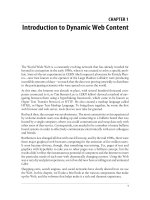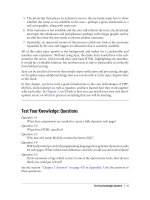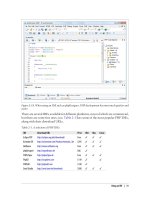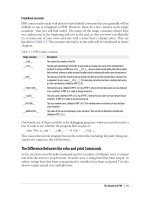Học php, mysql và javascript - p 38 pdf
Bạn đang xem bản rút gọn của tài liệu. Xem và tải ngay bản đầy đủ của tài liệu tại đây (1.58 MB, 10 trang )
Example 16-13. Using the push and pop methods
<script>
sports = ["Football", "Tennis", "Baseball"]
document.write("Start = " + sports + "<br />")
sports.push("Hockey")
document.write("After Push = " + sports + "<br />")
removed = sports.pop()
document.write("After Pop = " + sports + "<br />")
document.write("Removed = " + removed + "<br />")
</script>
The
three main statements of this script are shown in bold type. First the script creates
an array called sports with three elements and then pushes a fourth element into the
array. After that it pops that element back off. In the process, the various current values
are displayed using document.write. The script outputs the following:
Start = Football,Tennis,Baseball
After Push = Football,Tennis,Baseball,Hockey
After Pop = Football,Tennis,Baseball
Removed = Hockey
The push and pop functions are useful in situations where you need to divert from some
activity to do another, then return, as in Example 16-14.
Example 16-14. Using push and pop inside and outside of a loop
<script>
numbers = []
for (j=0 ; j<3 ; ++j)
{
numbers.push(j);
document.write("Pushed " + j + "<br />")
}
// Perform some other activity here
document.write("<br />")
document.write("Popped " + numbers.pop() + "<br />")
document.write("Popped " + numbers.pop() + "<br />")
document.write("Popped " + numbers.pop() + "<br />")
</script>
The output from this example is:
Pushed 0
Pushed 1
Pushed 2
Popped 2
Popped 1
Popped 0
JavaScript Arrays | 351
Using reverse
The reverse method simply reverses the order of all elements in an array. Exam-
ple 16-15 shows this in action.
Example 16-15. Using the reverse method
<script>
sports = ["Football", "Tennis", "Baseball", "Hockey"]
sports.reverse()
document.write(sports)
</script>
The original array is modified and the output from this script is:
Hockey,Baseball,Tennis,Football
sort
With the sort method, you can place all the elements of an array in alphabetical or
other order, depending upon the parameters used. Example 16-16 shows four types of
sort.
Example 16-16. Using the sort method
<script>
// Alphabetical sort
sports = ["Football", "Tennis", "Baseball", "Hockey"]
sports.sort()
document.write(sports + "<br />")
// Reverse alphabetical sort
sports = ["Football", "Tennis", "Baseball", "Hockey"]
sports.sort().reverse()
document.write(sports + "<br />")
// Ascending numerical sort
numbers = [7, 23, 6, 74]
numbers.sort(function(a,b){return a - b})
document.write(numbers + "<br />")
// Descending numerical sort
numbers = [7, 23, 6, 74]
numbers.sort(function(a,b){return b - a})
document.write(numbers + "<br />")
</script>
The first of the four example sections is the default sort method, alphabetical sort, while
the second uses the default sort and then applies the reverse method to get a reverse
alphabetical sort.
352 | Chapter 16: JavaScript Functions, Objects, and Arrays
The third and fourth sections are a little more complicated by using a function to com-
pare the relationships between a and b. The function doesn’t have a name, because it’s
used just in the sort. You have already seen the function named function to create an
anonymous function; we used it to define a method in a class (the showUser method).
Here, function creates an anonymous function meeting the needs of the sort method.
If the function returns a value greater than zero, the sort assumes that a comes before
b. If the function returns a value less than zero, the sort assumes that b comes before
a. The sort runs this function across all the values in the array to determine their order.
By manipulating the value returned (a - b in contrast to b - a), the third and fourth
sections of Example 16-16 choose between an ascending numerical sort and a descending
numerical sort.
And, believe it or not, this represents the end of your introduction to JavaScript. You
should therefore now have a core knowledge of the three main technologies covered in
this book. The next chapter will look at some advanced techniques used across these
technologies, such as pattern matching and input validation.
Test Your Knowledge: Questions
Question 16-1
Are JavaScript functions and variable names case-sensitive or -insensitive?
Question 16-2
How can you
write a function that accepts and processes an unlimited number of
parameters?
Question 16-3
Name a way to return multiple values from a function.
Question 16-4
When defining a class, what keyword is used to refer to the current object?
Question 16-5
Do all the methods of a class have to be defined within the class definition?
Question 16-6
What keyword is used to create an object?
Question 16-7
How can a property or method be made available to all objects in a class without
replicating the property or method within the object?
Question 16-8
How can you create a multidimensional array?
Test Your Knowledge: Questions | 353
Question 16-9
What syntax is used to create an associative array?
Question 16-10
Write a statement to sort an array of numbers in descending numerical order.
See the section “Chapter 16 Answers” on page 448 in Appendix A for the answers to
these questions.
354 | Chapter 16: JavaScript Functions, Objects, and Arrays
CHAPTER 17
JavaScript and PHP Validation and
Error Handling
With your solid foundation in both PHP and JavaScript, it’s time to bring these tech-
nologies together to create web forms that are as user-friendly as possible.
We’ll be using PHP to create the forms and JavaScript to perform client-side validation
to ensure that the data is as complete and correct as it can be before it is submitted.
Final validation of the input will then be made by the PHP, which will, if necessary,
present the form again to the user for further modification.
In the process, this chapter will cover validation and regular expressions in both Java-
Script and PHP.
Validating User Input with JavaScript
JavaScript validation should be considered an assistance more to your users than to
your websites because, as I have already stressed many times, you cannot trust any data
submitted to your server, even if it has supposedly been validated with JavaScript. This
is because hackers can quite easily simulate your web forms and submit any data of
their choosing.
Another reason you cannot rely on JavaScript to perform all your input validation is
that some users disable JavaScript, or use browsers that don’t support it.
So the best types of validation to do in JavaScript are checking that fields have content
if they are not to be left empty, ensuring that email addresses conform to the proper
format, and ensuring that values entered are within expected bounds.
355
The validate.html Document (Part One)
So let’s take a general sign-up form, common on most sites that offer memberships or
registered users. The inputs being requested will be forename, surname, username,
password, age, and email address. Example 17-1 provides a good template for such a
form.
Example 17-1. A form with JavaScript validation (part one)
<html><head><title>An Example Form</title>
<style>.signup { border: 1px solid #999999;
font: normal 14px helvetica; color:#444444; }</style>
<script>
function validate(form) {
fail = validateForename(form.forename.value)
fail += validateSurname(form.surname.value)
fail += validateUsername(form.username.value)
fail += validatePassword(form.password.value)
fail += validateAge(form.age.value)
fail += validateEmail(form.email.value)
if (fail == "") return true
else { alert(fail); return false }
}
</script></head><body>
<table class="signup" border="0" cellpadding="2"
cellspacing="5" bgcolor="#eeeeee">
<th colspan="2" align="center">Signup Form</th>
<form method="post" action="adduser.php"
onSubmit="return validate(this)">
<tr><td>Forename</td><td><input type="text" maxlength="32"
name="forename" /></td>
</tr><tr><td>Surname</td><td><input type="text" maxlength="32"
name="surname" /></td>
</tr><tr><td>Username</td><td><input type="text" maxlength="16"
name="username" /></td>
</tr><tr><td>Password</td><td><input type="text" maxlength="12"
name="password" /></td>
</tr><tr><td>Age</td><td><input type="text" maxlength="3"
name="age" /></td>
</tr><tr><td>Email</td><td><input type="text" maxlength="64"
name="email" /></td>
</tr><tr><td colspan="2" align="center">
<input type="submit" value="Signup" /></td>
</tr></form></table>
As it stands, this form will display correctly but will not self-validate, because the main
validation functions have not yet been added. Even so, if you type it in and save it as
validate.html, when you call it up in your browser, it will look like Figure 17-1.
356 | Chapter 17: JavaScript and PHP Validation and Error Handling
How it works
Let’s look at
how this document is made up. The first three lines set up the document
and use a little CSS to make the form look a little less plain. The parts of the document
related to JavaScript come next and are show in bold.
Between the <script > and </script> tags lies a single function called validate that
itself calls up six other functions to validate each of the form’s input fields. We’ll get
to these functions shortly. For now I’ll just explain that they return either an empty
string if a field validates, or an error message if it fails. If there are any errors, the final
line of the script pops up an alert box to display them.
Upon passing validation, the validate function returns a value of true; otherwise, it
returns false. The return values from validate are important, because if it returns
false, the form is prevented from being submitted. This allows the user to close the
alert pop up and make changes. If true is returned, no errors were encountered in the
form’s fields and so the form is allowed to be submitted.
The second part of this example features the HTML for the form with each field and
its name placed within its own row of a table. This is pretty straightforward HTML,
with the exception of the onSubmit="return validate(this)" statement within the
opening <form > tag. Using onSubmit, you can cause a function of your choice to be
called when a form is submitted. That function can perform some checking and return
a value of either true or false to signify whether the form should be allowed to be
submitted.
Figure 17-1. The output from Example 17-1
Validating User Input with JavaScript | 357
The this parameter is the current object (i.e., this form) and is passed to the validate
function just discussed. The validate function receives this parameter as the object
form.
As you can see, the only JavaScript used within the form’s HTML is the call to return
buried in the onSubmit attribute. Browsers with JavaScript disabled or not available will
simply ignore the onSubmit attribute, and the HTML will display just fine.
The validate.html Document (Part Two)
Now we come to Example 17-2, a set of six functions that do the actual form field
validation. I suggest that you type all of this second part in and append it to the first
half, which you should already have saved as validate.html. It’s fine to include multiple
<script> sections in a single HTML file. If you prefer, you can incorporate the additional
code into the first <script> section from Example 17-1.
Example 17-2. Part two of the JavaScript validation form
<script>
function validateForename(field) {
if (field == "") return "No Forename was entered.\n"
return ""
}
function validateSurname(field) {
if (field == "") return "No Surname was entered.\n"
return ""
}
function validateUsername(field) {
if (field == "") return "No Username was entered.\n"
else if (field.length < 5)
return "Usernames must be at least 5 characters.\n"
else if (/[^a-zA-Z0-9_-]/.test(field))
return "Only a-z, A-Z, 0-9, - and _ allowed in Usernames.\n"
return ""
}
function validatePassword(field) {
if (field == "") return "No Password was entered.\n"
else if (field.length < 6)
return "Passwords must be at least 6 characters.\n"
else if (!/[a-z]/.test(field) || ! /[A-Z]/.test(field) ||
!/[0-9]/.test(field))
return "Passwords require one each of a-z, A-Z and 0-9.\n"
return ""
}
function validateAge(field) {
if (isNaN(field)) return "No Age was entered.\n"
else if (field < 18 || field > 110)
return "Age must be between 18 and 110.\n"
358 | Chapter 17: JavaScript and PHP Validation and Error Handling
return ""
}
function validateEmail(field) {
if (field == "") return "No Email was entered.\n"
else if (!((field.indexOf(".") > 0) &&
(field.indexOf("@") > 0)) ||
/[^a-zA-Z0-9.@_-]/.test(field))
return "The Email address is invalid.\n"
return ""
}
</script></body></html>
We’ll
go through
each of these functions in turn, starting with validateForename so you
can see how validation works.
Validating the forename
validateForename is quite a short function that accepts the parameter field, which is
the value of the forename passed to it by the validate function.
If this value is an empty string, an error message is returned; otherwise, an empty string
is returned to signify that no error was encountered.
If the user entered spaces in this field, it would be accepted by validateForename, even
though it’s empty for all intents and purposes. You can fix this by adding an extra
statement to trim whitespace from the field before checking whether it’s empty, use a
regular expression to make sure there’s something besides whitespace in the field, or—
as I do here—just let the user make the mistake and allow the PHP program to catch
it on the server.
Validating the surname
The validateSurname function is almost identical to validateForename in that an error
is returned only if the surname supplied was the empty string. I chose not to limit the
characters allowed in either of the name fields to allow for non-English and accented
characters, etc.
Validating the username
The validateUsername function is a little more interesting, because it has a more com-
plicated job. It has to allow only the characters a-z, A-Z, 0-9, _ and -, and ensure that
usernames are at least five characters long.
The if else statements commence by returning an error if field has not been filled
in. If it’s not the empty string, but is less than five characters in length, another error
message is returned.
Then the JavaScript test function is called, passing a regular expression (which matches
any character that is not one of those allowed) to be matched against field (see the
Validating User Input with JavaScript | 359
section “Regular Expressions” on page 361). If even one character that isn’t one of the
acceptable ones is encountered, the test function returns false and so validateUser
name returns an error string. Otherwise, an empty string is returned to signify that no
error was found.
Validating the password
Similar techniques are used in the validatePassword function. First the function checks
whether field is empty, and an error is returned if it is. Next, an error message is
returned if a password is shorter than six characters.
One of the requirements we’re imposing on passwords is that they must have at least
one each of a lowercase, uppercase, and numerical character, so the test function is
called three times, once for each of these cases. If any one of them returns false, one
of the requirements was not met and so an error message is returned. Otherwise, the
empty string is returned to signify that the password was OK.
Validating the age
validateAge returns an error message if field is not a number (determined by a call to
the isNaN function), or if the age entered is lower than 18 or greater than 110. Your
applications may well have different or no age requirements. Again, upon successful
validation the empty string is returned.
Validating the email
Last, and most complicated, the email address is validated with validateEmail. After
checking whether anything was actually entered, and returning an error message if it
wasn’t, the function calls the JavaScript indexOf function twice. The first time a check
is made to ensure there is a period (.) somewhere from at least the second character of
the field, and the second checks that an @ symbol appear somewhere at or after the
second character.
If those two checks are satisfied, the test function is called to see whether any disal-
lowed characters appear in the field. If any of these tests fail, an error message is re-
turned. The allowed characters in an email address are uppercase and lowercase letters,
numbers, and the _, -, period, and @ characters, as detailed in the regular expression
passed to the test method. If no errors are found the empty string is returned to indicate
successful validation. On the last line, the script and document are closed.
Figure 17-2 shows the result of clicking on the Signup button without having completed
any fields.
Using a separate JavaScript file
Of course, because they are generic in construction and could apply to many types of
validations you might require, these six functions make ideal candidates for moving
360 | Chapter 17: JavaScript and PHP Validation and Error Handling









